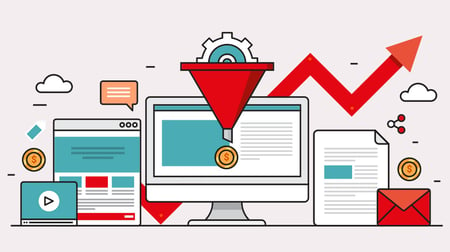
When you use HubSpot, you have several ways to optimize your website conversion rate.
In this blog, we will discuss four of the many ways you can use HubSpot to improve your conversion rate.
#1 Make use of A/B testing
HubSpot allows you to run A/B tests. With an A/B test, you test two versions of the same page to see which of the two performs better. For example, you can format the same page twice, but use a different tone-of-voice when creating the content. Half the users will then see one version of the page and the other half the other version.
By making use of this A/B testing-process, you can see which version works best with your visitors. With an A/B test, you can perform other experiments besides tone-of-voice. Consider, for instance, the place of a Call-to-Action (CTA) on the page, different images or a different approach within the hero.
#2 Deploy HubSpot's personalization capabilities
Personalizing content is a proven method to achieve better conversion rates. In fact, personalization also increases relevance and trust.
HubSpot lets you get started with personalization in a variety of ways. For example, think of creating a marketing email for an email list, addressing each user by their first name.
This makes an email feel a lot more personal than a standard newsletter with a general greeting and a user will therefore be more inclined to actually read the email.
You can also work with personalisation tokens within HubSpot CMS. This means you can reflect personalized content on your website based on data from your contacts within the CMS. For example, you can show personalized content based on someone's name or the organization where they work.
In addition, HubSpot CMS also allows you to deploy 'smart' CTAs that provide a personalized CTA. With this option, you ensure that a user is shown a different CTA depending on different criteria. Smart rules for a CTA you deploy based on the following criteria of the visitor:
- The country where the visitor is located
- Device
- Reference source
- Preferred language
- Membership of contact list within the HubSpot CRM
- Phase within the customer lifecycle within the HubSpot CRM
#3 Optimize conversion-oriented pages (such as landing pages)
Landing pages are crucial in increasing your conversions. This is because a landing page is the page a user lands on when they click on an ad or want to register for an event, for example.
This type of page takes care of the final step: gathering data and actually making the conversion happen. So by optimizing these pages, you ensure better conversion rates.
There are several ways you can optimize a landing page, including:
- Coming up with a catchy title based on the what-how-why principle.
- Writing effective copy
- Using catchy CTAs
- Creating targeted lead generation forms
#4 Manage and analyze your ad-performance with HubSpot
To generate conversions with your website, the first thing you need to do is attract visitors to your website. This can be done by using SEO, but also by using online ads. You can use ads on various media channels, such as Google Ads, Facebook and LinkedIn. Because the data of these ads reside in different databases, it can sometimes be difficult to analyze and manage them effectively.
Fortunately, you can gather the data from your ads within HubSpot's Marketing Hub and thus analyze the data in one clear overview. By linking your advertising channels and HubSpot, you also ensure that collected leads show up directly in the CRM. In this way, you also immediately ensure proper follow-up with automated emails, for example. Good follow-up is crucial in increasing your conversion rate.
Check your website for critical points to improve your conversion rate
Want to know if your website is optimized for generating conversions? Schedule a call and we’ll check together how your website scores on critical points for conversion.

